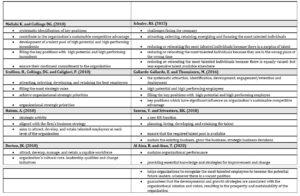Introduction
In the current economy, the main elements that lead to the development of organizations are high-performance technologies, information and the innovation capacity. Due to this, the human resource becomes the main factor of production within organizations, especially those employees who have a high level of knowledge and skills, possess the ability to constantly learn and develop, adapt quickly to new technologies and develop new technologies, and also have the ability to interact with other employees within the organization in order to share the knowledge. That is why, among modern organizations, there is a strong competition for attracting and retaining talents, meaning those employees who possess a high level of knowledge and skills, especially because of the fact that their number on the labour market is low.
The talent management topic was brought into focus in 1997, when the consulting group McKinsey devised the phrase “The War for Talent “. As well, the birth and development of the talent management concept was also due to employees’ optics changes. Nilsson, S. and Ellström, PE. (2012, p. 27) found that there had been a change of optics between the period in which learning was considered to be only the education received before the start of their careers, and that job security and lifelong employment were paramount for employees. Nowadays, it has shifted to lifelong learning, employability and talent management. They felt that the main challenge was that employees need to stay up to date with the changes and adapt to the evolving needs of organizations.
Grigorescu, A. and Chiper, A. (2016, p. 80) emphasized the importance of investing in human capital (ensuring protection and evaluation, adequate remuneration and rewards, as well as continuous development), taking into account that, by increasing the level of knowledge and own experience that this capital puts in the service of the organization, it contributes to increasing the efficiency of the other factors of production, considering that, currently, human capital is the main factor of production. The authors emphasize that this capital has an essential contribution, through the creativity it demonstrates, to the long-term strategy of the organization (Grigorescu, A. and Chiper, A., 2016, p. 78).
Regarding the evolution in time of talent management approach, Collings, DG. and Mellahi, K. (2009) concluded that, despite the fact that talent management presented a significant degree of interest, both academically and practically, the topic still remained underdeveloped. They found that the main limitations that led to this were that talent management did not yet have a consistent definition and no clear conceptual boundaries. In all the period since the implementation of this term in the business vocabulary until now, its approach has been made especially by consulting and management firms, by practitioners in these fields and less in an academic approach, which led to the lack of a theoretical framework. This idea is underlined by Iles, P., Preece, D. and Chuai, X. (2010) who considered that the lack of theoretical justifications and conceptual development in the literature could be attributed in part to the fact that most of the literature in this field was written by practitioners or consultants.
It should be noted that, in this article, no distinction will be made between talent management, strategic talent management and global talent management, given that many authors, including Gallardo-Gallardo, E. and Thunnissen, M. (2016), consider that strategic talent management and global strategic management represent two conceptualizations of talent management.
Digitalization represents another key concept that is debated in the literature. It is linked to the impact of the new technologies on the organizations, with the major changes that are involved and with the never before speed of these changes that organizations should face. The main question is if organizations are able to adapt to these changes and if their response will be fast enough, in order to allow them to remain sustainable and to preserve their competitive advantage. As we will see in this article, many organizations are not ready to face this challenge, even if it will allow an increase in productivity, innovation and sustainability. Digitalization produces a major transformation both for employees (work task transformation) and for organizations (new business models, new technological solutions) and provides new values for customers.
The paper has three objectives:
- To identify a unitary definition of talent management, by analysing all the definitions that were given in the literature over the time
- To identify the influence that digitalization has on talent management components: talent identification and selection, talent attraction, talent development and talent retention
- To identify the components of talent management which are most influenced by digitalization
In order to achieve the objectives, we formulated two research questions:
- Which are the main aspects that should be used in order to obtain a consistent talent management definition?
- How does the implementation of digitalization support the organizations to maintain a sustainable talent management?
Literature Review
Defining Talent Management
Kontoghiorghes, C. (2015, p. 2) considered that, although talent management is a very popular topic in recent years, there is still considerable disagreement among researchers regarding its definition and its basic practices. The author noted that talent management was generally approached as a process of transformation of human resources, without taking into account the effects of relevant organizational factors (Kontoghiorghes, C., 2015, p. 3). In the same direction, Thunnissen, M., Boselie, P. and Fruytier, B. (2013, p. 1756) showed that, for the most part, the literature on talent management refers to the importance of human capital and especially talent and the impact produced on the labour market by the evolution and trends in talent management, as well as the gap between the supply and demand for human capital for organizations. The authors also pointed out that the impact of other competitive and institutional mechanisms is barely explored. Regarding this topic, Kontoghiorghes, C., 2015, p. 3) considered that talent management has the role of helping the organization to respond to the challenges of the external environment, its effectiveness being influenced, however, by the characteristics of the internal environment. The author considered that the approaches used so far prevent the development of a holistic understanding of the factors that influence it, as well as of its true effects.
Egerova, D., (2014, p. 114-115) identified, in a unitary form, the main issues related to the concept of talent management:
– The term talent management is characterized by a multitude of definitions and a lack of consensus
– Talent management focused on a limited set of human resources’ practices and activities, especially attracting, retaining and developing the best employees
– Talent management has focused in particular on its economic value
– Talent management studies have focused in particular on multinationals and large national companies
– Talent management was approached from a unitarist vision, regarding the organization as a homogeneous body, within which all actors work together to achieve its objectives
The lack of a theoretical framework has led to the existence of several ways of interpreting the term talent management and to the lack of a uniform definition of the term talent management, as well as to different approaches regarding its purpose and scope. There are those who argue that, in fact, the term talent management was only used to present the old methods used by human resources in a new form, while others believed that the term refers only to career planning practices or the management of talented employees (Lewis, RE. and Heckman, RJ., 2006). This latter approach leads to the need to create talent bases and focus management’s attention on designing employee needs and managing employee progress within the organization. The authors emphasize that organizations, in order to achieve their goals, are concerned with attracting only high-performing employees, who in turn will want to work alongside other high-performing employees, which will lead to increased talent within the organization. But in this way, the identification of the talent inherent in each individual will be missed, which could make the organization miss the opportunity to differentiate from other organizations. Referring to these two aspects when approaching talent management, Iles, P., Preece, D. and Chuai, X., (2010) ascertain that there has been and there still is controversy in the literature about how talent management is used, if it is necessary to use it exclusively for high-potential or high-performing employees or also for other employees. The second approach, according to the authors, contributes to the development of an organizational competency. This second approach can avoid organizational knowledge loss and reduce the level of “inert knowledge” (Bratianu, C., 2021). The organizations will be able to benefit from a more efficient knowledge structure and a more intense knowledge transfer (Bratianu, C. Prelipcean, G. and Bejinaru, R.,2020). On the other hand, this approach will allow organizations to secure their intellectual capital reserve (Bratianu C., 2007) within their own employees, by identifying and developing those with special qualities and high potential.
Collings, DG. and Mellahi, K. (2009) showed that the key positions are not limited to the management team and that they can vary over time and between different operating units. Connected to this approach, Scullion, H., Collings, DG. and Caligiuri, P. (2010) consider that studies should be focused also on the different ways in which it should be implemented in different national contexts. Farndale, E., Scullion, H. and Sparrow, P. (2010, p. 161) identified two other aspects of global talent management, namely the international growth of the talent competition and new forms of international mobility, mobility that should lead organizations to improve their ability to manage talent, especially in emerging markets.
Lewis, RE. and Heckman, RJ. (2006, p. 139) noted that the term talent management suffers from conceptual confusion, and there are still serious shortcomings in its definition, purpose, and general objectives. The authors identified three theories regarding the definition of talent management. A first theory defines talent management with reference in general to the recruitment, selection and development of personnel, as well as career and succession management, which are generally practices, functions and activities specific to human resources departments. The authors pointed out that for those who embraced this theory, talent management “requires you to do what human resources have always done, but to do it faster (through the Internet or outsourcing) or in the enterprise (rather than within a department or function)”. A second direction was based on the concept of talent pools. This theory took into account the need for a set of processes that would ensure the necessary flow of employees into workplaces throughout the organization. The third perspective on talent management focuses on talent in a generic way, without taking into account organizational boundaries or specific positions (Lewis, RE. and Heckman, RJ., 2006, p.141).
In 2005, Huselid, MA., Beatty, RW. and Becker, BE. had shown that the field of talent management must have different approaches to that of human resources and focus the attention on identifying key positions within the organization, positions that should be occupied by top employees (Huselid, MA., Beatty, RW. and Becker, BE., 2005,1). However, Tarique, I. and Schuler, R. (2010, p.124) showed that in the studies conducted there are three different approaches to talent management: in terms of HR practices and functions, in terms of planning and projecting employee needs and by a focus granted to talents.
Another controversy is related to the way in which the need for talent is ensured within the organization. There are opinions pro attracting these talents from outside the organization, while more and more voices support the idea that organizations should pay more attention to identifying employees with high potential within their own employees (Ready, DA. and Conger, JA., 2007). Maślanka-Wieczorek, B. (2014, p.103), based on the studies conducted by Juchowicz, warned even that attracting talent from other organizations, without careful analysis, can be an inappropriate action, since talent can be specific to a particular organization and it is not always possible to be transferred between organizations.
Fedorova, ES., Naumov, KV., Kalinina, OK. and Sedyakina, AA. (2020) consider that, during its evolution, six approaches have been created within the talent management theory:
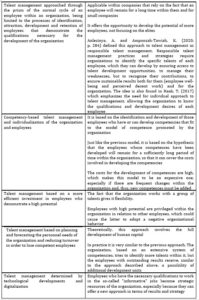
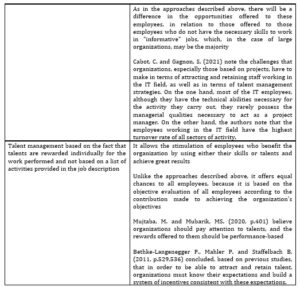
Gallardo-Gallardo, E., Dries, N. and González-Cruz, TF., (2013, p. 290) note that: “literature has focused in particular on practices (“how”) and less on (“who”) is considered talented and (“why”)”. The authors identified four directions for future research, the most important being the further development of the theory on talent management, so that it can be demonstrated that talent management presents its own approach and brings additional value to the concepts used also by related fields. Thunnissen, M., Boselie, P. and Fruytier, B., (2013, p.1758), Gallardo-Gallardo, E., Dries, N. and González-Cruz, TF., (2013, p.298) and Tansley, C., Kirk, S. and Tietze, S. (2013, p.338) have made a series of proposals that, in their opinion, will allow the development of talent management as a field of academic research:
– Expanding the existing narrow approach to talent management
– Introducing new points of view that take into account the organizational context and the actors within the organization, who are in interdependence
– Exploring the ways in which organizations currently define talent, as well as researching the dominant typologies within organizations and their effect
-Expanding the narrow approach on talent management to the people in the organization and their work
– Focusing the study especially on employees and not on managers and HR specialists to study talent management
– Conducting studies on the role and impact of different actors interested in talent management policies and their impact
– Study of talent management in other types of organizations, for example, small and medium-sized enterprises, public institutions
– Development and testing of the current talent management framework
Defining Digitalization
I-SCOOP in “Digitization, digitalization, digital and transformation: the differences” considers that digitalization means “turning interactions, communications, business functions and business models into (more) digital ones which often boils down to a mix of digital and physical as in omnichannel customer service, integrated marketing or smart manufacturing with a mix of autonomous, semi-autonomous and manual operation” and “the use of digital technologies and of data (digitized and natively digital) in order to create revenue, improve business, replace/transform business processes (not simply digitizing them) and create an environment for digital business, whereby digital information is at the core.”
Legner, C., Eymann, T., Hess, T., Matt, C., Böhmann, T., Drews, P., Mädche, A., Urbach, N. and Ahlemann, F., (2017) note that there is often confusion between the term digitalization and that of digitization or even that of digital transformation. The authors note that digitalization describes “the manifold sociotechnical phenomena and processes of adopting and using digital technologies in broader individual, organizational, and societal contexts”. It is worth pointing out that Hess, T., Matt, C., Benlian, A. and Wiesböck, F. (2018), although they believe there is an important difference between digitization and digital transformation, referring to digital transformation, they say that it is also known as digitalization. Collington, R. (2022, p. 313) also uses the expression “digitalization – elsewhere termed ‘digital transformation’”.
Starting from DIKK model, as described by Bratianu, C. and Bejinaru, R. (2023), we tried to understand if digitization, digitalization and digital transformation are able to support knowledge dynamic. Data, the raw of material for information as the authors said can be make more accessible by digitization. View that information is the result of processed data (Bratianu, C. and Bejinaru, R.,2023, p.200), information will be obtained easily and will be shared more effectively by using digitalization. Meanwhile, digitalization will also support knowledge acquisition and knowledge sharing. Digital transformation will reinforce knowledge acquisition by cloud-computing, VR and AR, but will also deal with wisdom, as a result of processing knowledge (Bratianu, C. and Bejinaru, R.,2023, p.202), machine-learning and AI. Part of wisdom will ever remain as specific attribute of mankind.
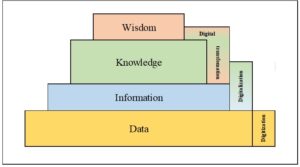
Fig.1. From digitization to digital transformation
Referring to digitalization (automation), Sirnicek, N. and Williams, A. (2015, p.112-113) consider that it is not possible to fully implement it in practice and that machine will not replace human factor for jobs based on flexibility, affectivity, and creativity, and especially for task based more on tacit than on explicit knowledge.
The influence of digitalization on talent management
Anlesinya, A., Dartey-Baah, K. and Amponsah-Tawiah, K. (2019, p. 308) identified the need for future studies regarding the opportunities and challenges of strategic talent management digitalization. In this direction, Stander, FW., Rothmann, S., Popov, V. and Sun, L. (2022, 522) conclude that, by using the right digital tools, the organizations will manage to leverage the opportunities for talent management, will have the chance of implementing the best practices. In the same time, in order to sustain the organizational develoment goals, talent management approaches should be based on digital dexterity (Ahmed, W., Hizam, SM. and Sentosa, I., 2022, p. 633). Learning by using digital platforms is another major benefit provided by digitalization, because they will be able to ensure personalized learning programs, which will provide to the organizations a stable talent supply to an optimal cost (Mukerjee, HS., Acharya, S., Stl, V. & Ghosh, V., 2023, p. 329).
Benitez-Amado, J., Llorens-Montes, FJ. and Fernandez-Perez, V. (2015, p.208) have demonstrated through their study that IT infrastructure capability contributes to talent management by supporting the organization in recruiting and attracting talents, with the help of the information provided, helps configure working culture, contributes to improving working conditions, as well as talent development. Phillips-Wren, G., Doran, R. and Merrill, K. (2016, p. 461) consider that organizations will be able to compete for talented employees and to control identification and recruitment costs by using social media networks. On the opposite, Meijerink, J., Boons, M., Keegan, A. and Marler, M. (2021, p. 2549, 2558) conclude that, if the used algorithms are not transparent regarding their way of learning, the sources of their learning and the way in which they add or adjust parameters, this can conduct to amplifying biases regarding some groups of candidates (e.g., discrimination reinforcement). This is the reason for which organizations approach differently digitalization in talent identification processes. Some of them consider digital talent management technology to be “error-free”, so that human factor has no added value and others consider the technology results should be supervised by a human decision (Wiblen, S. and Marler, JH., 2021, p. 2612).
Martínez-Morán, P.C., Urgoiti, JMF-R., Díez, F. and Solabarrieta, J. (2021, p. 13-14), in a study conducted within companies in Spain, notes the increasingly frequent use by companies of digital techniques in different stages related to talent management, mainly in the attraction stage, especially in order to strengthen their employer brand. The authors conclude, however, that if in terms of identifying, attracting and recruiting talents, professional social networks are increasingly used, from the moment in which the employee is selected, face-to-face communication still prevails, and the trainings are also carried out, in particular, in a face-to-face or hybrid format.
da Silva, LBP. et al. (2022, p. 15-16) believe that digital technologies (artificial intelligence, virtual reality, augmented reality and big data) will contribute to talent retention through changing the company’s image and will be able to predict and limit turnover through a predictive analysis of talents. The authors also believe that these technologies can contribute to the rapid filling of a vacancy by quickly scanning the CVs, according to the required qualifications. In the same direction, Saxena, R. and Kumar, Y. (2021) present the multiple uses that digital training can have in terms of developing talent management within organizations. The authors note that artificial intelligence will be able to support organizations in identifying positions for which employees demonstrate outstanding skills, their allocation to those positions, as well as the continuous development of talents (Saxena, R. and Kumar, Y., 2021, p. 118), will influence recruitment processes and talent acquisition, as well as the decision of organizations whether to acquire or develop talent (Saxena, R. and Kumar, Y., 2021, p. 118). On the same topic, Conte, C. and Siano, A. (2023) find that organizations will be able to achieve an increased return on investment in talent, if they improve internal communication and recruitment communication, taking advantage of the opportunities offered by big-data. Wiblen, S. and Marler, JH. (2021, p. 2595-2596) present the advantages that technology brings talent management (digital talent management), the most important being, in our opinion, the following:
- Providing organizations with a mechanism that allows them to create and develop a unitary system in terms of talent management – all employees must go through the same processes and be subjected to the same practices
- The possibility to create a unified and accessible talent database – very useful in terms of access to a talent pool
- Support in identifying those people in whom they must be invested and who must be kept within the organization – which facilitates the decision of the organization regarding the development of certain employees, as well as in terms of building personalized employee value propositions for these employees in order to retain them
- Support in terms of identifying talents, by attaching labels like high performer, high potential or success to each person, following the analysis of experience, knowledge, both technical and personal, personal qualities, analysis that is made based on the required skills
Lin, L-H. and Wang, KJ. (2022, p.2) emphasize that in Work 4.0 talent management will be marked by uncertainty, the challenges that organizations will face, produced by technological evolution, being the reduction of the number of available talents and the changes in the characteristics of work. In these conditions, a sustainable development of talents will be more and more difficult to achieve, which is why talent retention will become essential. In order to overpass the shortage in e-skills and digital fluency capabilities, the organizations changed their recruitment policies and start to have a more global sourcing policy, than a local one (Thite, M., 2022, p.89). And global talent search and retention is facilitated by e-HRM (Bondarouk, TV. and Ruël, HJM., 2009, p. 509). In the same direction, the Gartner Executive Programs’ report highlighted the concerns of the Chief Information Officers participating in the survey regarding the new qualifications that talents will have to gain in order to be able to put into operation the essential sketches to be made to the IT system, namely those related to digital design, data science, digital anthropology, which is why 39% of them believe that a major talent review could occur in IT (Gartner Executive Programs, 2014, p. 6). Even 44% from the executives “continue to demonstrate a lack of digital talent” (Shao, Z., Li, X., Luo, Y. and Benitez, J., 2022, p. 2). On the other hand, Hanelt, A., Firk, S., Hildebrandt, B. and Kolbe, LM. (2021, p. 17) underline the fact that hiring digital talents will not provide the benefits of ease of knowledge utilization and combination to the organization if no digital technologies are in place.
Regarding the positive impact that digitalization has on employee retention and talent attraction, i-SCOOP in “What is digital business transformation? The essential guide to DX” shows that employee retention is increased by digitalization (the intention to leave the organization is 4% in digital savvy organizations, compared to 20% in non-savvy ones), this also contributes to attracting talent: 71% of digitally mature organizations are able to attract talent, while only 10% of those in an early digital stage have this capacity.
Grigorescu, A., Pelinescu, E., John, AE. and Dutcas, MF. (2021, p.3-4) emphasize that digitalization has produced transformations that have led to change both in society and in the economy, given that it has led to the need to acquire digital skills, to be used both within the organization and in leisure. Within the current and rapid technological changes, human capital must acquire new technical qualifications and new behaviors that allow it to interact with new technologies, interact in virtual space, develop communication skills and align with the rules of ethics and responsibility (Grigorescu, A., Pelinescu, E., John, A.E. and Dutcas, MF.,2021, p.2).
Machine learning and artificial intelligence are able to offer to the organizations a more objective and fair talent management (Loyarte-López, E. and García-Olaizola, I., 2022, p. 2151160-15), improve both hiring and training processes (Zoltners, AA., Sinha, P., Sahay, D., Shastri, A. and Lorimer, SE., 2021, p. 89), support organizations in recruiting and selecting personnel (Palos-Sánchez, PR., Baena-Luna, P., Badicu, A. and Infante-Moro, JC., 2022, p. 2145631-3649), and reduce employee turnover (Lilly, A., Rajkumar, R. and Amudha, R., 2022). Big data offer to the employers the opportunity to enlarge and to diversify the talent pool and to use the necessary information in order to recruit the desired employees, with significant recruitment cost cutting (Garcia-Arroyo, J. And Osca, A. (2021, p. 4346). Social media are very useful in connecting job seekers with organizational recruiters and offer to the last the opportunity of experimenting a new recruitment strategy (Phillips-Wren, G., Doran, R. and Merrill, K., 2016, p. 454).
Methodology
Talent Management Definition
Based on the analyzed literature, we identified a number of 16 definitions that were given to the talent management construct over the time (Appendix 1). Starting from these definitions, we identified the main ideas that were used by the authors to define the analyzed concept.
Using these ideas, we have developed a definition of talent management that is as comprehensive as possible and that best reflects both the implication that this process has on organizations and on their employees, both on those considered to be talents and on other employees.
Establishing The Interest Regarding Analyzed Topics
We performed the research in order to identify the interest for the chosen topics and to find out the countries in which the largest number of papers was published.
Talent Management
Our research identified a number of 2.373 papers in Web of Science and a number of 2.482 papers in Scopus (Web of Science was interrogated on the 13th of April, 2023, and Scopus was interrogated on the 14th of April, 2023). From this number, in our analysis, we did not consider a number of 350 papers (14,10%) from Scopus (72 reported for 2023 and 278 papers reported for the period 2001-2010, view the reduced number of papers published / year – we considered only the years in which were published more than 100 papers / year). From Web of Science, we did not consider a number of 188 papers (7,92%): 47 reported for 2023 and 141 papers reported for the period 2002-2010, view the reduced number of papers published / year and in order to be consequent with the period considered for Scopus.
Digitalization
Our research identified a number of 18.409 papers in Web of Science and a number of 32.592 papers in Scopus (the databases were interrogated on the 24th of April, 2023). From this number, in our analysis, we did not consider a number of 3.821 papers (11,72%) from Scopus (2.108 reported for 2023 and 1.713 papers reported for the period 1922-2001, view the reduced number of papers published / year – we considered only the years in which were published more than 100 papers / year). From Web of Science, we did not consider a number of 1.449 papers (7,87%): 1.064 reported for 2023 and 385 papers reported for the period 1975-2001, view the reduced number of papers published / year and in order to be consequent with the period considered for Scopus).
Paper analysis in order to find the papers with reference to the analyzed topics
In order to perform the research, we used the query presented as follows “Talent management AND Digitalization
Talent management – Bibliometric Analysis
We performed a bibliometric analysis on talent management using the following methodology:
- The file for import from Web of Science was obtained by using the condition “All fields” and “Full Record & Cited References”
- VOSviewer was used to perform the bibliometric analysis. For the file obtained from Web of Science was used “Co-occurrence” / “Author keywords” and 5 as the minimum number of occurrences of a keyword
- The software returns 220 keywords which met the threshold of a minimum 5 occurrences of a keyword, from a total number of 5.454 keywords (from which only 215 were connected to other items)
- The keywords considered as being irrelevant were eliminated (49 keywords)
- The option “thesaurus” was used in order to eliminate the words with the same meaning, but with a different way of writing.
The purpose of the bibliometric analysis was to identify the link strength between the core topic, talent management, and digitalization.
Findings And Results
Talent Management Definition
We define talent management as the strategic and holistic approach, anticipating and meeting the organizational needs for human capital and assuring a systematic identification of key positions, based on activities and processes using both HR policies and complementary HR policies and an approach to business planning, in order to attract, to identify, to develop, to engage, to retain or to deploy a capable workforce, by managing the abilities, competencies, skills, needs, concerns, careers, fears and expectations of the people and by filling the key positions with high potential and high performing employees, so that the right person is in the right job, without unnecessary costs, for sustaining the business grow, the strategic business decisions and priorities, organizational performance, the organization’s sustainable competitive advantage, by ensuring the essential knowledge and strategies for improvement and change and by meeting the organizational mission and vision.
Results regarding the interest shown in the analyzed concepts
After performing the analysis, we obtained the following results for the evolution of the papers published every year and for the countries in which they were published. Only for talent management were analyzed also the number of papers published by the authors with the biggest authority in this domain.
Talent Management
The evolution of the number of papers published every year demonstrates the increasing interest for the topic talent management.
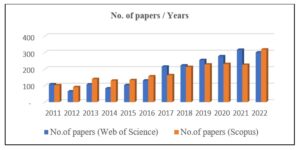
Fig.2. No. of papers published every year on the topic talent management
However, our results are in line with the results mentioned by other authors: research on talent management was quite low until the year 2008. McDonnell A., Collings DG., Mellahi K. and Schuler R. (2017, p. 89), following their analysis, found that 93% of the articles published on talent management were published after 2008, fact that demonstrates the growing interest on this topic. If in the first five months of 2013 the authors identified a number of 14 papers, our research identified in the first four months of 2023 a number of 47 papers in Web of Science and a number of 72 articles in Scopus.
The bellow charts present the number of papers published in the main 10 contributing countries to the development of talent management research, which represent 74,46% from the articles indexed in Web of Science and 71,51% from the articles indexed in Scopus. From the number of papers published in these countries, 53,99% of the papers indexed in Web of Science were published in only three countries (USA, United Kingdom and Hungary) and 69,30% from the papers indexed in Scopus were published in only four countries (USA, United Kingdom, India and China). This demonstrated that the interest regarding this topic was developed only in a limited number of countries.

Fig.3. No. of papers published in each country on the topic talent management (Web of Science)

Fig.4. No. of papers published in each country on the topic talent management (Scopus)
Our research identified that the following authors were the main contributors in the field of talent management.
Table 1: Main contributing authors – talent management concept
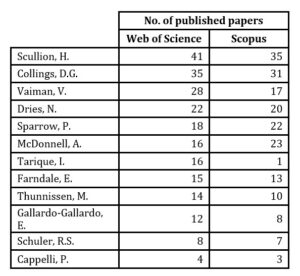
We tried to understand why the quantity of papers written on the topic talent management is so limited, view that from the literature review we concluded that it is a concept of main interest. We perform both in Web of Science and in Scopus an interrogation for related topics: talent pool, talent acquisition, talent attraction, talent identification, talent development and talent retention, and we obtained the following results (interrogation made in both databases on 2nd of May, 2023):
Table 2: No. of papers written on each topic
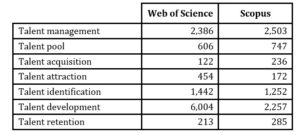
An explanation regarding the reduced number of published papers could be the one offered by Collings, DG., Scullion, H. and Vaiman, V. (2015, p.234-235) which finds that, due to the non-existence of an agreement regarding the conceptualization of talent management, there is still a skepticism in the academic environment about this concept, which makes it rarely used as such in the papers. This fact leads to an underestimation of the volume of theoretical and practical papers on this subject and, on the other hand, it can create difficulties in identifying certain works with reference to talent management, due to the use of erroneous keywords.
Digitalization
The evolution of the published papers demonstrates that digitalization became a more and more researched topic and that the interest in this concept increased mainly starting with 2017.
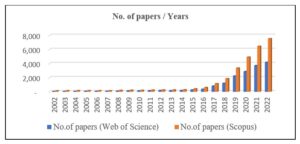
Fig.5. No. of papers published every year on the topic digitalization
As in case of talent management, we analyzed the number of papers published in the main 10 contributing countries. The bellow graphs present the number of papers which were published in these countries, representing 73,70% from the articles indexed in Web of Science and 69,76% from the articles indexed in Scopus. The percentage represents the percentage of papers published in each country in reference with the total number of papers published in these countries.
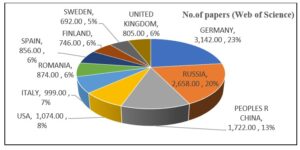 Fig.6. No. of papers published in each country on the digitalization (Web of Science)
Fig.6. No. of papers published in each country on the digitalization (Web of Science)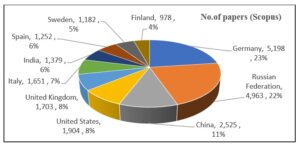
Fig.7. No. of papers published in each country on the digitalization (Scopus)
Articles with reference to the analyzed topics
The results of our research identified a small number of articles which treat at the same time talent management and digitalization.
Table 3: of papers identified by using the query
 An explanation for the reduced number of articles in which the relations between the two concepts are analyzed could be found in the above charts. The countries which are main contributors regarding the articles which approach talent management are the USA, the United Kingdom, India, Hungary and China, but the largest number of articles referring to digitalization were published in Germany, Russia and China. In order to demonstrate our hypothesis, we performed a co-authorship by country’s bibliometric analysis using the talent management database exported from Web of Science. The following table demonstrates the weak relationships of cooperation as we already assumed
An explanation for the reduced number of articles in which the relations between the two concepts are analyzed could be found in the above charts. The countries which are main contributors regarding the articles which approach talent management are the USA, the United Kingdom, India, Hungary and China, but the largest number of articles referring to digitalization were published in Germany, Russia and China. In order to demonstrate our hypothesis, we performed a co-authorship by country’s bibliometric analysis using the talent management database exported from Web of Science. The following table demonstrates the weak relationships of cooperation as we already assumed
Table 4: Link strength – co-authorship by country
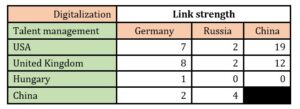
Another explanation could be that, in many works referring to talent management, digitalization appears under different designations as: digital tools, digital technology/technologies/techniques, digital platforms, digital transformation, artificial intelligence, machine learning, virtual reality, augmented reality, cloud computing, computerization or, even, automation.
Talent management – results of the bibliometric analysis
After performing the bibliometric analysis, we obtained the following network visualization:
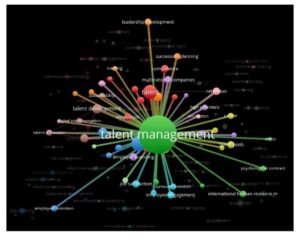
Fig.8. The most widely used keywords related to talent management– by VOSviewer
Source: Author’s own research
The strongest link strengths that we determined between talent management and other topics are presented in the following table:
Table 5: Link strength between talent management and concepts presented bellow

The link strengths that we obtained for human resources management and talent are in line with what we expected from the literature review. Unexpected low results were obtained for the components of talent management (talent retention, talent identification, talent attraction) and also for talent pool. Withal, unexpected low link strengths were obtained with concepts which are determinants for talent management: employee engagement, employer branding, talent attraction, leadership development, organizational commitment and succession planning. The conclusion could be only one: most of the articles written on the topic of talent management do not debate also about its components, which are analyzed in articles only in relation with the above-mentioned organizational behaviors and processes. Regarding the low link strength obtained between talent management and talent attraction, it is interesting to analyze the bellow images.
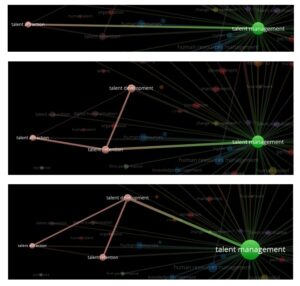
Fig.9. Links between talent management and its components– by VOSviewer
Source: Author’s own research
We can remark thar talent attraction is linked to talent management both directly and by the intermediate of talent retention and talent development. Also, talent development and talent retention are linked to talent management both directly and by the intermediate of each other. This means that talent attraction is influenced by talent development / talent retention and talent development and talent retention influence each other. It is normal. A talented employee who is satisfied with his/her development within the organization has no turnover intention and advocates for the employer outside the organization, contributing to the increase of employer branding. On the other hand, a talent without turnover intention is interested in developing itself inside the organization and a continuous development program determines the talent to remain inside the organization.
It is very interesting to underline the fact that Cluster 8 (brown) contains “talent acquisition”, “talent attraction”, “talent development” and “talent retention” together with “digital transformation”, “digitalization”, “information technology”, “future of work” and “social networks”, which means there are semantic connections between these concepts.
But, despite this fact, we identified a link strength of only 3 between talent management and digitalization. View the small number of articles in which the two topics are co-occurrents, the result was expected.
We tried to find out if digitalization has strongest link strength with the components of talent management and we obtained the following results:
Table 6: Links strength between digitalization and talent management components
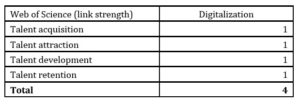
View the unexpected results, we extend our research and we perform a bibliometric analysis using the concept “digitalization”, in order to identify the topics to which both talent management and digitalization are connected.
We found a number of 22.049 papers in Web of Science, which were processes on the 2nd of May, 2023. The file for import from Web of Science was obtained by using the condition “All fields” and “Full Record & Cited References”
VOSviewer was used to perform the bibliometric analysis. For the file obtained from Web of Science was used “Co-occurrence” / “Author keywords” and 50 as the minimum number of occurrences of a keyword. The software returns 321 keywords which met the threshold of a minimum 50 occurrences of a keyword, from a total number of 59.821 keywords, and 115 keywords were eliminated, view their irrelevance for our study and the option “thesaurus” was used.
The bibliometric analysis returns the following network visualization.
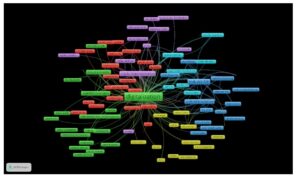
Fig.10. The most widely used keywords related to digitalization– by VOSviewer
Source: Author’s own research
Using both bibliometric analyses performed before we tried to identify the concepts with which both talent management and digitalization are connected. The bellow table presents the main concepts linked with talent management and the link strength between these topics and digitalization.
Table 7: Links strength between talent management, digitalization and other topics
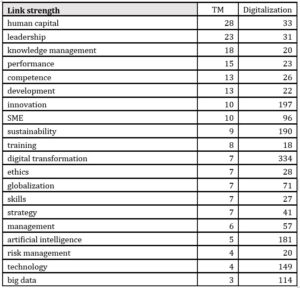
We can remark that the most balanced topics in term of link strength, connected both with talent management and digitalization, are “knowledge management”, “human capital”. “leadership” and “performance”.
Conclusions
Taking into account the growing interest that the topic talent management have, both in the academic environment and in the management, we expect to identify a larger number of papers published on this topic. An explanation for this could be that, for a very long time, only companies have focused on this subject, the academic environment being, for a long time, skeptical of this subject. The fact that there has been controversy over the definition of talent management has led many researchers to avoid using the term and to publish their papers on the subject using other approaches. This could also lead to confusion about keywords to be used when it is desired to identify the works that address this topic.
In the work was formulated a definition of talent management that tries to present a larger picture of this concept. The definition was obtained by joining within a unitary definition the elements considered to be essential (Appendix 2), identified by analyzing some definitions given over time (Appendix 1).
The bibliometric analysis provided results that did not meet the expectations we had from the literature review. In the research undertaken, we found that talent management influences, but especially is influenced by, digitalization. Or, following the bibliometric analysis, we identified the weak link strengths between management and the other analyzed topic. It is worth mentioning that the links have only been identified between talent management and digitalization, there being no connection between them and global talent management and, respectively, strategic talent management. In conclusion, the lack of a distinction in the work between talent management, strategic talent management, and global talent management is not a limitation of research.
Weak link strength was obtained also for the topics very closely related to talent management: talent, talent acquisition, talent attraction, talent development, talent identification and talent retention. The only explanation regarding the result obtained is that, being new, the topics were not studied yet in relation with each other for a large number of researchers.
As we already concluded, it is possible that talent management and its components have been studied in relationship with other topics that are sometimes used instead of digitalization: digital tools, digital technology/technologies/techniques, digital platforms, digital transformation. And, considering the link strength found between digitalization and human capital, it is possible that most of the papers tried to study only this relationship.
We consider this fact as an opportunity for further research.
References
- Ahmed, W., Hizam, SM. and Sentosa, I. (2022), ‘Digital dexterity: employee as consumer approach towards organizational success’, Human Resource Development International, 25(5), 631-641.
- Al Aina, R. and Atan, T. (2020), ‘The Impact of Implementing Talent Management Practices on Sustainable Organizational Performance’, Sustainability, 12, 1-21.
- Anlesinya, A., Dartey-Baah, K. and Amponsah-Tawiah, K. (2019), ‘Strategic talent management scholarship: a review of current foci and future directions, Industrial and Commercial Training’, 51(5), 299-314.
- Anlesinya, A. and Amponsah-Tawiah, K. (2020), ‘Towards a responsible talent management model’, European Journal of Training and Development, 44 (2/3), 279-303.
- Ashton, C. and Morton, L. (2005), ‘Managing talent for competitive advantage: Taking a systemic approach to talent management’, Strategic HR Review, 4(5), 28 – 31.
- Benitez-Amado, J., Llorens-Montes, FJ. and Fernandez-Perez, V. (2015), ‘IT impact on talent management and operational environmentalsustainability’ Information Technology and Management, 16, 207–220.
- Bethke-Langenegger P., Mahler P. and Staffelbach B. (2011), ‘Effectiveness of talent management strategies’, European J. International Management, 5(5), 524-539.
- Bondarouk, TV. and Ruël, HJM. (2009), ‘Electronic Human Resource Management: challenges in the digital era’, The International Journal of Human Resource Management, 20(3), 505-514.
- Bratianu, C. (2007) ‘An integrated perspective on the organizational intellectual capital’, Review of Management and Economical Engineering, 6(5), 107-112.
- Bratianu, C., Prelipcean, G. and Bejinaru, R. (2020), ‘Exploring the latent variables, which support SMEs to become learning organizations’, Management & Marketing. Challenges for the Knowledge Society, 15(2), 154-171.
- Bratianu, C. (2021) ‘Knowledge dynamics: A semantic approach’ In: Garcia-Perez, A. & Simkin, L. (Eds.). Proceedings of the 22nd European Conference on Knowledge Management (ECKM). A virtual conference hosted by Coventry University, UK, 2-3 September 2021, p. 96-103.
- Bratianu, C. and Bejinaru, R. (2023), ‘From Knowledge to Wisdom: Looking beyond the Knowledge Hierarchy’, Knowledge, 3, 196–214.
- Cabot, C. and Gagnon, S. (2021), ‘Understanding the career dynamics of IT professionals in digital transformation times: a systematic review of career anchors studies’, International Journal of Information Systems and Project Management, 9(2), 44-60.
- Cappelli, P. (2008) ‘Talent Management for the Twenty-First Century’, Harvard Business Review, March 2008, 1-8.
- Cappelli, P. (2014) ‘Talent Management: Conceptual Approaches and Practical Challenges’, Annual Review of Organizational Psychology and Organizational Behavior, 305-331.
- Collings, DG. And Mellahi, K. (2009), ‘Strategic talent management: A review and research agenda’, Human Resource Management Review, 19(4), 304–313.
- Collings, DG., Scullion, H. and Vaiman, V. (2015), ‘Talent management: Progress and prospects’, Human Resource Management Review, 25, 233–235
- Collington, R. (2022) ‘Disrupting the Welfare State? Digitalisation and the Retrenchment of Public Sector Capacity’, New Political Economy, 27(2), 312-328
- Conte, C. and Siano, A. (2023), ‘Data-driven human resource and data-driven talent management in internal and recruitment communication strategies: an empirical survey on Italian firms and insights for European context’, Corporate Communications: An International Journal, Emerald Publishing Limited, https://www.emerald.com/insight/1356-3289.htm
- da Silva, LBP., Soltovski, R., Pontes, J., Treinta, FT., Leitao, P., Mosconi, E., de Resende, LMM. and Yoshino, RT. (2022), ‘Human resources management 4.0: Literature review and trends’, Computers & Industrial Engineering, 168, 1-20.
- Dorton, JK. (2010) The “Moon’s Shots of 21th Century Talent”: Comparative Corporate Training and Leadership Development at General Electric and Toyota, DBA Thesis
- Egerová, D. (2014) ‘Talent management– towards the new perspectives’, Problems of management in the 21st century, 9(2), 114-116.
- Elegbe, JA. (2010), Talent Management in the Developing World. Adopting a Global Perspective, Routledge, NY
- Farndale, E., Scullion, H. and Sparrow, P. (2010), ‘The role of the corporate HR function in global talent management’, Journal of World Business, 45(2), 161-168.
- Fedorova, ES., Naumov, KV, Kalinina, OK, and Sedyakina, AA. (2020), ‘The development of integrated approaches to talent management in the organization’, IOP Conf. Ser.: Mater. Sci. Eng., 940
- Gartner Executive Programs (2014) Taming the Digital Dragon: The 2014 CIO Agenda Insights From the 2014 Gartner CIO Agenda Report https://www.gartner.com/imagesrv/cio/pdf/cio_agenda_execsum2014.pdf
- Gallardo-Gallardo, E., Dries, N. and González-Cruz, TF. (2013), ‘What is the meaning of ‘talent’ in the world of work?’, Human Resource Management Review, 23(4), 290-300.
- Gallardo-Gallardo, E. and Thunnissen, M. (2016), ‘Stranding on the shoulders of giants? A critical review of empirical TM research’, Employee Relations, 38(1), 31-56.
- Garcia-Arroyo, J. And Osca, A. (2021), ‚Big data contributions to human resource management: a systematic review’, The International Journal of Human Resource Management, 32(20), 4337-4362.
- Grigorescu, A. and Chiper, A. (2016), ’The importance of the human capital in the strategic developmenht of the organization’, Studies of Scientific Researches. Economics Edition, Special issue, June 2016, 77-82.
- Grigorescu, A., Pelinescu, E., Ion, AE. and Dutcas, MF. (2021), ’Human Capital in Digital Economy: An Empirical Analysis of Central and Eastern European Countries from the European Union’, Sustainability, 13, 1-21.
- Haak, T. (2017) ‘8 talent management trends for 2018’, HR Trend Institute, [Online], [Retrieved April 29,2023] https://hrtrendinstitute.com/2017/07/24/8-talent-management-trends-for-2018/
- Hanelt, A., Firk, S., Hildebrandt, B. and Kolbe, LM. (2021), ‘Digital M&A, digital innovation, and firm performance: an empirical investigation’, European Journal of Information Systems, 30(1), 3-26.
- Hess, T., Matt, C., Benlian, A. and Wiesböck, F. (2018), ‘Options for Formulating a Digital Transformation Strategy’, MIS Quarterly Executive, 15(2), 123-139.
- Hatum, A. (2010), Next Generation Talent Management – Talent Management to Survive Turmoil, Palgrave Macmillan, Houndmills, Basingstoke, Hampshire
- Huselid, MA., Beatty, RW. and Becker, BE. (2005), ‘“A players” or “A positions?” The strategic logic of workforce management’, Harvard Business Review, December, 110-117.
- Iles, P., Preece, D. and Chuai, X. (2010), ‘Talent management as a management fashion in HRD: Towards a research agenda’, Human Resource Development International, 13(2), 125–145.
- Kontoghiorghes, C. (2015) ‘Linking high performance organizational culture and talent management: satisfaction/motivation and organizational commitment as mediators’, The International Journal of Human Resource Management, 1-21.
- Legner, C., Eymann, T., Hess, T., Matt, C., Böhmann, T., Drews, P., Mädche, A., Urbach, N. and Ahlemann, F., (2017), ‘Digitalization: opportunity and challenge for the business and information systems engineering community’, Inform. Syst. Eng, 59 (4), 301–308.
- Lewis, RE. and Heckman, RJ. (2006), ‘Talent management: A critical review’, Human Resource Management Review, 16(2), 139–154.
- Lilly, A., Rajkumar, R. and Amudha, R. (2022), ‘Aggrandizing the human resource development with underpinning artificial intelligence’, Journal of Statistics and Management Systems, 25(5), DOI: 10.1080/09720510.2022.2040859
- Lin, L-H.and Wang, K-J. (2022), ‘Talent Retention of New Generations for Sustainable Employment Relationships in Work 4.0 Era—Assessment by Fuzzy Delphi Method’, Sustainability, 14, 2-18.
- Loyarte-López, E. and García-Olaizola, I., (2022), ‘Machine Learning Based Method for Deciding Internal Value of Talent’, Applied Artificial Intelligence, 36(1), 2151160-1-2151160-19
- Meijerink, J., Boons, M., Keegan, A. and Marler, M. (2021), ‘Algorithmic human resource management: Synthesizing developments and cross-disciplinary insights on digital HRM’, The International Journal of Human Resource Management, 32(12), 2545-2562.
- Martínez-Morán, PC., Urgoiti, JMF-R., Díez, F. and Solabarrieta, J. (2021), ‘The Digital Transformation of the Talent Management Process: A Spanish Business Case’, Sustainability, 13, 1-16.
- Maślanka-Wieczorek, B. (2014) ‘Talent management and high performance work system’, Journal of International Studies, 7(1), 102-108.
- McDonnell A., Collings DG., Mellahi K.and Schuler R. (2017), ‘Talent management: a systematic review and future prospects’, European Journal of International Management, 11(1), 86-128.
- Mellahi, K. and Collings, DG (2010), ‘The barriers to effective global talent management: The example of corporate élites in MNEs’, Journal of World Business, · 45(2), 143-149.
- Mujtaba, M. and Mubarik, MS. (2020), ‘Talent management and organizational sustainability: role of sustainable behaviour’, International Journal of Organizational Analysis, 30(2), 389-407.
- Mukerjee, HS., Acharya, S., Stl, V. and Ghosh, V. (2023), ‘Business-techno [IT] consultants: A critical assessment of the digital future talent and learning needs’, Human Resource Development International, 26(3), 321-330.
- Nilsson, S. and Ellström, P.-E. (2012), ‘Employability and talent management: challenges for HRD practices’, European Journal of Training and Development, 36(1), 26–45.
- Palos-Sánchez, PR., Baena-Luna, P., Badicu, A. and Infante-Moro, JC. (2022), ‘Artificial Intelligence and Human Resources Management: A Bibliometric Analysis’, Applied Artificial Intelligence, 36(1), 2145631-3628-2145631-3655.
- Phillips-Wren, G., Doran, R. and Merrill, K. (2016), ‘Creating a value proposition with a social media strategy for talent acquisition’, Journal of Decision Systems, 25(1), 450-462.
- Ready, A. and Conger, JA. (2007), ‘Make your company a talent factory’, Harvard Business Review, 85(6), 68–70.
- Saxena, R. and Kumar, Y. (2021), Influence of Artificial Intelligence on Work, People and the Firm: A Multi-Industry Perspective, Chapter 7, Human & Technological Resource Management (HTRM): New Insights into Revolution 4.0, Emerald Publishing Limited,111–132.
- Saxena, V. and Srivastava, RK. (2018), ‘Talent management is as critical as capital investment’, International Journal of Business Management & Research, 8(4), 27-32.
- Schuler, RS. (2015) ‘The 5-C framework for managing talent’, Organizational Dynamics, 44, 47—56.
- Scullion, H., Collings, DG. and Caligiuri, P. (2010), ‘Global talent management’, Editorial, Journal of World Business, 105-108.
- Shao, Z., Li, X., Luo, Y. and Benitez, J. (2022), ‘The differential impacts of top management support and transformational supervisory leadership on employees’ digital performance’, European Journal of Information Systems, DOI: 10.1080/0960085X.2022.2147456
- Sirnicek, N. and Williams, A. (2015), Inventing the future: postcapitalism and world without work, Verso, New Yor
- Starik, M. and Rands, GP. (1995), ’Weaving an integrated web: multilevel and multisystem perspectives of ecologically sustainable organizations’, Academy of Management Review, 20(4), 908-935.
- Stander, FW., Rothmann, S., Popov, V. and Sun, L. (2022), ‘A framework for digital talent assessment: Guidelines and applications’, Journal of Psychology in Africa, 32(5), 520-525.
- Stitt, D. (2012), Talent Management, Strategy Research Project, United States Army War College
- Tansley, C., Kirc, S. and Tietze, S., (2013), ‘The currency of talent management – A reply to “talent management and the relevance of context: Towards a pluralistic approach’., Human Resource Management Review, 23(4), 337-340.
- Tarique, I. and Schuler, R. (2010), ‘Global talent management: Literature review, integrative framework, and suggestions for further research’, Journal of World Business, 45, 122-133.
- Thite, M. (2022) ‘Digital human resource development: where are we? Where should we go and how do we go there?’, Human Resource Development International, 25(1), 87-103.
- Thunnissen, M., Boselie, P. and Fruytier, B. (2013), ‘A review of talent management: ‘infancy or adolescence?’, The International Journal of Human Resource Management, 24(9), 1744–1761.
- Wiblen, S. and Marler, JH. (2021), ‘Digitalised talent management and automated talent decisions: the implications for HR professionals’, The International Journal of Human Resource Management, 32(12), 2592–2621.
- Zoltners, AA., Sinha, P., Sahay, D., Shastri, A. and Lorimer, SE. (2021), ‘Practical insights for sales force digitalization success’, Journal of Personal Selling & Sales Management, 41(2), 87-102.
Electronic References
Appendix 1 – Talent Management Definitions
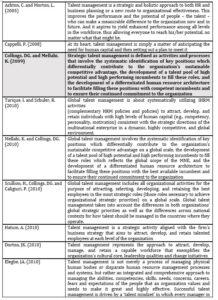
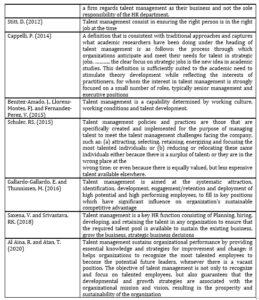
Appendix 2 – Main aspects identified in talent management definitions

